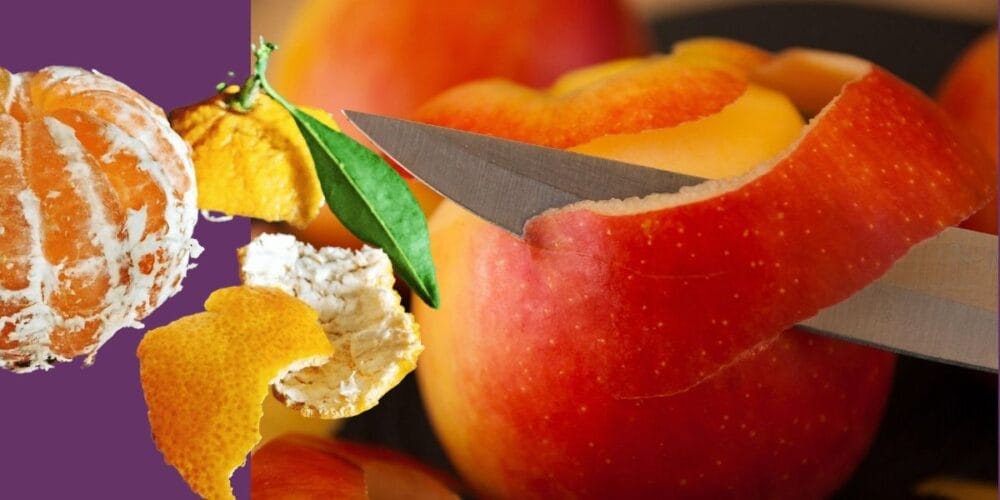Fruit and Vegetable Skins You Should Stop Peeling for Better Nutrition
Before tossing out those fruit and vegetable skins, think again! The peel you’re about to discard may hold more nutrients, fibre, and antioxidants than the flesh itself.
From improving digestion to boosting heart health, certain peels are rich in beneficial compounds such as polyphenols, vitamins, and minerals. While not all skins are safe—such as mango or lychee rinds—many are edible and can help you cut down food waste while enhancing your nutrition naturally.
Table of Contents
Here’s a list of eight fruit and vegetable skins worth keeping on your plate.
1. Kiwi Skin: Fibre and Antioxidant Power
That fuzzy kiwi skin might look unappetizing, but it’s a fibre and vitamin goldmine. Eating the whole kiwi can double your fibre intake and add vitamin C, vitamin E, and polyphenols to your diet. Research suggests that consuming kiwis with their skin supports gut health and helps lower inflammation.
Also Read: Skin Of A Kiwi: Valuable And Nutritional Powerhouse in the Peel.
2. Tomato Skin: Rich in Lycopene and Minerals
Tomato skins contain up to 2.5 times more lycopene than the pulp. This antioxidant helps protect your skin from sun damage and promotes collagen production, resulting in smoother, more youthful-looking skin. The peel also provides valuable minerals, including zinc, manganese, and copper, to enhance your nutrient intake.
3. Watermelon Rind: The Hidden Superfood
Don’t stop at the red part! Watermelon rind is edible and packed with fibre, citrulline, and vitamins C and B6. Citrulline can support blood circulation and maintain healthy blood pressure. Try using the rind in stir-fries, smoothies, or even pickled—it’s a crunchy, nutrient-dense addition to your meals.
4. Citrus Peel: Zesty Flavour with Health Benefits
Citrus zest from oranges, lemons, or limes doesn’t just add fragrance—it offers fibre, vitamin C, and powerful bioflavonoids. These compounds support the immune system, reduce inflammation, and aid in digestion. Polyphenols, such as limonene found in lemon zest, are known for their antioxidant and heart-protective properties.
5. Potato Skin: A Nutrient-Dense Layer
Potato skins are nutritional powerhouses, providing more vitamin C, folate, potassium, and magnesium than the peeled potato. They’re also high in fibre, which improves digestion and helps you feel full longer. Potato peel extracts have even shown potential in promoting collagen production and acting as natural antioxidants.
6. Carrot Skin: Packed with Beta-Carotene
Keep the skin on your carrots to enjoy a higher dose of beta-carotene, an antioxidant the body converts into vitamin A. This nutrient supports good vision, skin health, and a strong immune system. The peel also contains beneficial phytonutrients that may help protect against chronic diseases.
7. Apple Peel: Antioxidant-Rich and Heart-Friendly
Apple peels are among the most nutritious food skins you can eat. They’re loaded with vitamin C, potassium, and fibre, helping enhance digestion and weight management. Antioxidants such as quercetin and chlorogenic acid in apple skins are associated with heart protection and a reduced risk of chronic illnesses.
8. Grape Skin: Natural Protection for Your Cells
Grape skins contain resveratrol, anthocyanins, and flavonoids—compound groups known for reducing inflammation and oxidative stress. Resveratrol, in particular, supports heart health and helps protect against certain types of cancer. Grape skin fibre also nurtures beneficial gut bacteria for a healthier digestive system.
Final Thoughts
Leaving the skins on your favourite fruits and vegetables isn’t just a time-saver—it’s a nutritional upgrade. These outer layers offer vital vitamins, minerals, antioxidants, and fibres often lost to the peel. Just be sure to wash your produce thoroughly and skip the skins of those known to cause reactions or toxicity.
Read more: Peel or no peel? How to enjoy 5 popular fruits for maximum health benefits.
